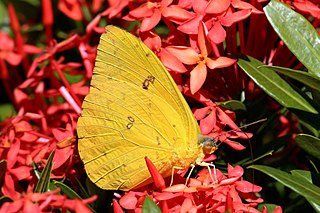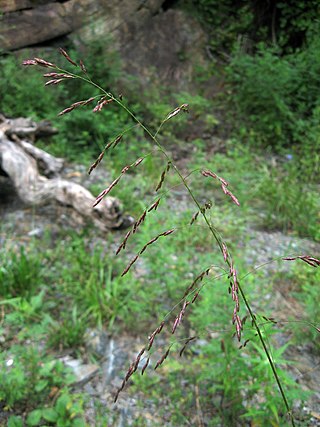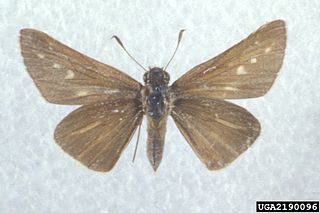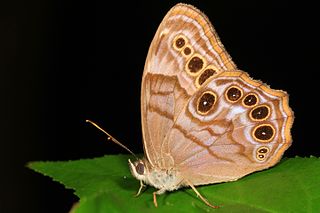
La Vernia is a city in Wilson County, Texas, United States. La Vernia is on the south bank of Cibolo Creek at the junction of U.S. Highway 87 and Texas Farm to Market Road 775, approximately 25 miles east of downtown San Antonio. The population was 1,077 at the 2020 census. La Vernia is part of the San Antonio Metropolitan Statistical Area.

Phoebis sennae, the cloudless sulphur, is a mid-sized butterfly in the family Pieridae found in the Americas. There are several similar species such as the clouded sulphur, the yellow angled-sulphur, which has angled wings, the statira sulphur, and other sulphurs, which are much smaller. The species name comes from the genus Senna to which many of the larval host plants belong.

Anthocharis midea, the falcate orangetip, is a North American butterfly that was described in 1809 by Jacob Hübner. It belongs to the family Pieridae, which is the white and sulphurs. These butterflies are mostly seen in the eastern United States, and in Texas and Oklahoma. They eat the nectar of violets and mustards. They tend to live in open, wet woods along waterways, in open swamps, and less often in dry woods and ridgetops. This species is a true springtime butterfly, being on the wing from April to May.

Oberthür's grizzled skipper is a species of skipper.

The eastern tailed-blue or eastern tailed blue, also known as Everes comyntas, is a common butterfly of eastern North America. It is a small butterfly that is distinguished from other blues in its range by the small thin tail.

Miletinae is a subfamily of the family Lycaenidae of butterflies, commonly called harvesters and woolly legs, and virtually unique among butterflies in having predatory larvae. Miletinae are entirely aphytophagous. The ecology of the Miletinae is little understood, but adults and larvae live in association with ants, and most known species feed on Hemiptera, though some, like Liphyra, feed on the ants themselves. The butterflies, ants, and hemipterans, in some cases, seem to have complex symbiotic relationships benefiting all.

Tridens flavus, known as purpletop, purpletop tridens, tall redtop, greasy grass, and grease grass, is a large, robust perennial bunchgrass native to eastern North America.

Eurema lisa, commonly known as the little yellow, little sulphur or little sulfur, is a butterfly species of subfamily Coliadinae that occurs in Central America and the southern part of North America.

Leptotes cassius, the Cassius blue or tropical striped blue, is a butterfly of the family Lycaenidae. It is found in North America in Florida including the Keys, Texas south through the Caribbean, Mexico, and Central America to South America. Strays have been found in New Mexico, Kansas, Missouri, South Carolina, North Carolina and Virginia.

Lerodea eufala, the Eufala skipper or rice leaffolder, is a species of butterfly in the family Hesperiidae. It is found from the coast of Georgia, south through Florida and west across the southern United States to southern California, south through Mexico and Central America to Patagonia. In the summer, it expands its range north to central California, North Dakota, southern Wisconsin, northern Michigan and Washington, D.C.

Hesperia metea, the cobweb skipper, is a butterfly of the family Hesperiidae. It has a scattered distribution in the United States from southern Maine west to Wisconsin, south to central Georgia, the Gulf States and central Texas.

Polites origenes, the crossline skipper, is a butterfly in the family Hesperiidae. It is found in the eastern United States, excepting Florida, southern Ontario, and Quebec.

Euphyes vestris, the dun skipper, sedge witch or dun sedge skipper, is a species of butterfly of the family Hesperiidae. It is found in North America from Nova Scotia west across southern Canada to southern Alberta, south to Florida, the Gulf Coast and eastern Texas. There are disjunct populations in the High Plains and Rocky Mountains and along the Pacific Coast.

Panoquina panoquin, the salt marsh skipper, is a butterfly of the family Hesperiidae. It is found along the Atlantic Coast of the United States, from New York south to Florida and the Florida Keys, west along the Gulf Coast to southern Texas.

Pieris krueperi, the Krueper's small white, is a butterfly in the family Pieridae. It is found on the Balkan Peninsula and in Iran, Baluchistan, the Kopet-Dagh and from Asia Minor to Central Asia, as well as in Oman. The habitat consists arid areas with scanty vegetation up to 2,500 metres (8,200 ft) in the mountains.

Hemiargus ceraunus, the Ceraunus blue, is a species of butterfly in the family Lycaenidae. The species was first described by Johan Christian Fabricius in 1793. It is found in the southwestern United States, southern Texas, Florida and the Florida Keys south through the West Indies, Mexico and Central America to South America. Strays may be found in North Carolina, Missouri, Kansas and Nevada. The habitat consists of open woodland, desert scrub, dunes, pastures, road edges and vacant lots.

Lethe anthedon, the northern pearly-eye, is a species of butterfly of the subfamily Satyrinae in the family Nymphalidae. It is found in North America, from central Saskatchewan and eastern Nebraska east to Nova Scotia, south to central Alabama and Mississippi.

Anaea are a genus of charaxine butterflies in the brush-footed butterfly family Nymphalidae. The butterflies are commonly known as leafwings. Members of the genus are found throughout the United States, Central America, and the Caribbean.

Vernia is a small genus of skippers in the family Hesperiidae. The genus was first named in 2019. It contains two species: Vernia dares and Vernia verna. Both species were formerly included in the genus Pompeius.





















